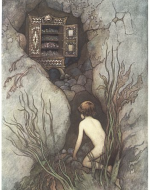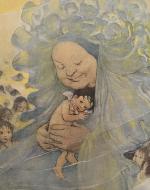Created by Catherine Golden on Sun, 08/25/2024 - 23:28
Description:
A very popular stable in the Victorian schoolroom, The Water-Babies (1863) is a fairy tale with a purpose now little read today. The protagonist named Tom, a chimney sweep with no morals or education, falls into a river and transforms into a "water baby." In his underwater world filled with fairies, water nymphs, and other water babies, Tom has a series of adventures and essentially undergoes a pilgrimage. He proves his worth and ultimately returns to the human world. Author Charles Kingsley, who was also a reverend, wrote the tale both to delight and instruct young readers about Christian morality, the wrongs of child labor, redemption, and openmindedness. Kingsley was a strong supporter of Charles Darwin, and evolutionary theory underpins this fairy tale.
The Water Babies first came out serially in Macmillan's (1862-63), an established literary periodical, and then in volume form (1863) with illustrations by Joseph Noel Paton; subsequent illustrators include Edward Linley Sambourne, Warwick Goble, William Heath Robinson, and Jessie Willcox Smith. The Water Babies regrettably reflects Nativist tendencies and prejudices of its time period, including disparaging comments about the Irish, Americans, Jews, Catholics, Blacks, and the poor. However, the book simultaneously contains progressive views on science and child labor and demonstrates how didacticism did not simply disappear from Victorian children's literature even as authors sought to entertain their child readers.
Charles Kingsley, The Water Babies (1863),1885 edition published by Macmillan, illustrated by Linley Sambourne, Wikipedia. The tale begins when a twelve-year-old chimney sweep named Tom is falsely accused of theft and chased from a wealthy home inhabited by an enchanting girl girl named Ellie. Tom flees, tumbles into the river, drowns, and becomes a water creature. He lives on the mythical Saint Brendan's Island where he meets his "princess'" Ellie again since she, too, falls into the river and becomes a water baby. Tom, along with the other water babies, has a series of magical underwater adventures that also inform a moral education. Most memorable are two fairies he meets--Mrs. Doasyouwouldbedoneby, who imparts the Golden Rule, and Mrs. Bedonnebyasyoudid, who teaches that if one transgresses, one's punishment fits the crime. As a fledgling water baby, Tom errs, but he ultimately learns his lessons, mends his ways, and becomes a good Christian boy; redeemed, he returns to the human world to become "a great man of science" who "can plan railways, and steam-engines, and electric telegraphs, and rifled guns, and so forth." In the coda entitled "Moral," Kingsley cautions the reader that this book is "all a fairy tale, and only fun and pretence; and therefore, you are not to believe a workd of it, even if it is true."
"Charles Kingsley," photograph by Charles Watkins, n.d., Wikimedia Commons. Charles Kingsley (1819-75) was a reverend, historian, and novelist. Kingsley's dress, manner, and expression in this photograph by Charles Watkins illustrates his refinement, intellect, and openmindedness. Raised in Devon where his father served as curate and then rector, Kingsley earned his degree at Magdalene College, Cambridge and then took holy orders in the Anglican Church. After serving as rector in Hampshire, Kingsley was appointed chaplain to Queen Victoria; he also became a History professor at Cambridge and private tutor to the Prince of Wales. Before his untimely death from pneumonia at the age of 55, he held posts in Chester Cathedral and Westminster Abbey. Kingsley embraced Charles Darwin's ideas about evolution and championed social reform; he instills his beliefs in The Water-Babies, a children's fairy tale that remained popular into the early twentieth century.
Linley Samburne, "Man is But a Worm," Punch 's Almanack for 1882, 1881-82. In this famous cartoon of evolutionary theory, Samburne, who also illustrated The Water-Babies with sensitivity, depicts the transformation of a worm into an ape and finally into a Victorian gentleman, top hat and all. Kingsley, an advocate of Darwin, approaches evolutionary theory, dubbed "Fairy Science." Under the sea, Tom initially struggles for survival, fearing being eaten by a salmon who, in turn, will be eaten by an otter. He recognizes that if he is to survive in this underwater world, he must stop pestering other water creatures and stealing sweets. Inverting Darwin's evolutionary theory, however, Kingsley's fairy tale asserts that just as beasts can evolve into humans, humans can degenerate into apes--the very path Tom is saved from by becoming a water baby and the fate of a sect of humans called the "Doasyoulikes," who gradually lose the power to speak and degenerate into gorillas. Falling into the womb-like underwater world, a reborn Tom escapes the evils of child labor, outgrows the savagery of his nature, moves up the evolutionary ladder, learns to make moral choices, and transforms into a moral individual as well as a celebrated scientist. Science and religion come together in this fairy tale; as Rosalind White advances in "The Water Babies and the Origins Debate" forThe Victorian Web, "faith in the universal laws of science becomes synonymous with faith in divine presence."
Warwick Goble, "He crept away among the rocks, and got to the cabinet, and behold! it was open," The Water-Babies (1863), by Charles Kingsley, 1909. Mrs. Bedonebyasyoudid first reprimands Tom for menacing sea creatures. This scene depicts two of Tom's additional transgressions--stealing and gluttony. Just before this scene, Tom grows overly fond of sea lollipops and goes in search of the fairy's sweets. Finding the cupboard door open, Tom gorges on sweets night after night. Every time Tom steals sweets, the candies lose some of their flavor, and he grows prickles. The fairy tells Tom, "'I should like to cuddle you; but I cannot, you are so horny and prickly.' And Tom looked at himself: and he was all over prickles, just like a sea-egg" (Ch. VI). Tom is punished for breaking Christian morality. He begs the fairy to "'take away all these nasty prickles,'" but the fairy responds, "'You put them there yourself, and only you can take them away'" (Ch. VI). The punishment fits the crime! Tom realizes he must change his ways to lose his prickles (Ch. VI). Warwick Goble, best known for his illustrations to H. G. Wells's The War of the Worlds, preserves this scene of temptation. Tom's gaze, not pictured, leads us directly to the open ornamental inlaid cupboard filled with tantalizing sweets. Tom's crouched position suggests he is about to rush to the cabinet and eat greedily. The open sweets cabinet first triggers Tom's undoing but ultimately launches his path to improvement.
Jessie Willcox Smith, "Mrs. Doasyouwouldbedoneby," for The Water Babies (1863), by Charles Kingsley, 1916 edition. Jessie Willcox Smith--an American illustrator during the Golden Age of Illustration--gained acclaim for her illustrations for Louisa May Alcott's Little Women and Robert Louis Stevenson's A Child's Garden of Verses, among other classics for children. Her illustrations for The Water-Babies are among her best-known. In this color illustration, Smith features the kind fairy, Mrs. Doasyouwouldbedoneby, cuddling Tom, now transformed into a water baby. She teaches Tom and the other water babies to act as you wish others to act towards you. To make her point, Smith lights up the fairy's smile and gentle nature. Tom, in turn, smiles with delight, as the other contented water babies look on longingly. While Mrs. Bedonebyasyoudid punishes the water babies for moral transgressions, Mrs. Doasyouwouldbedeoneby rewards goodness in this fairy tale with a purpose.






